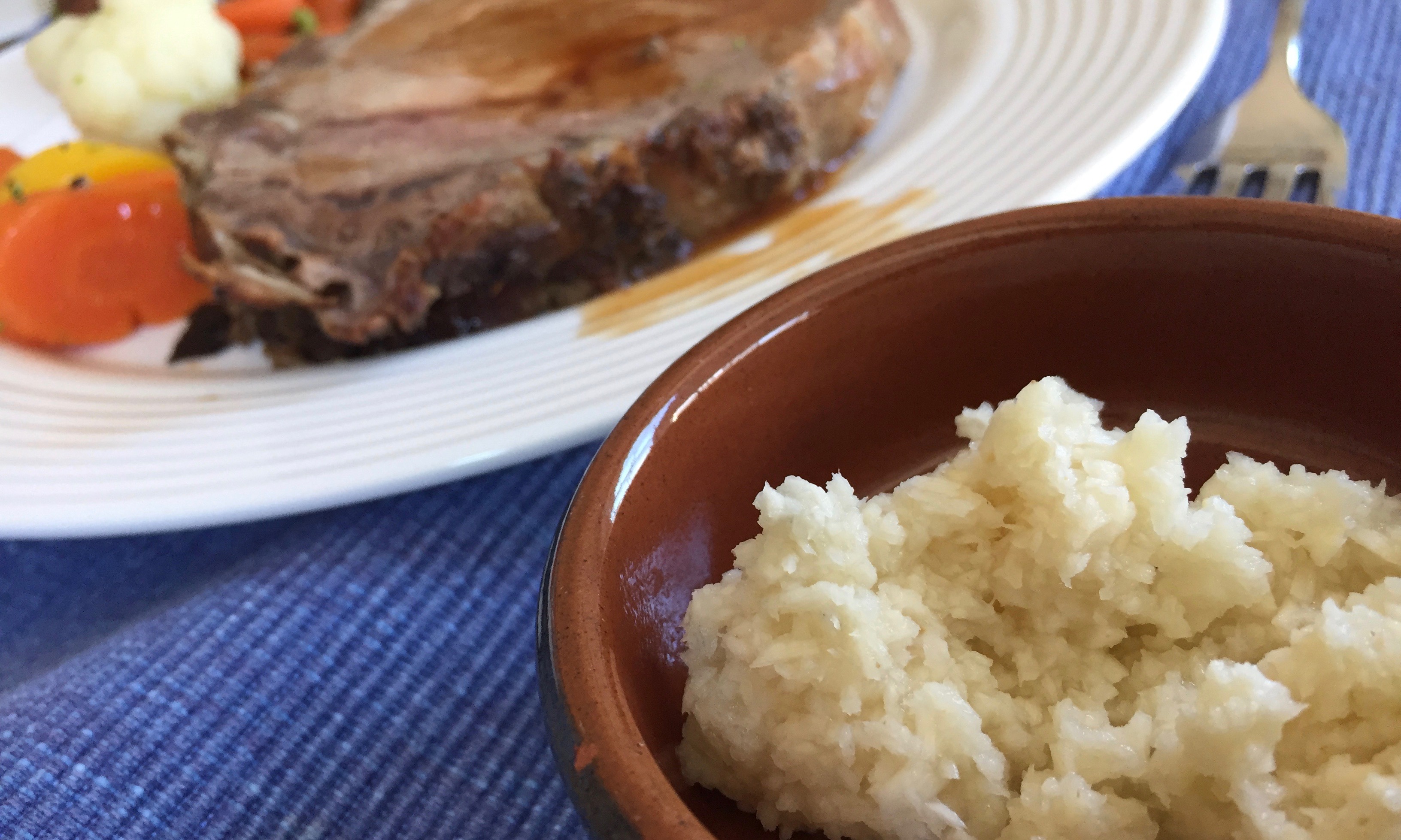During this holiday season, I’ve roasted two pork shoulders, helped pull more than 30 pounds of pork shoulder and made dozens of pulled pork sandwiches. I feel I’ve become fairly acquainted with Pork Shoulders.
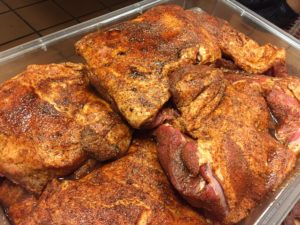
Professional cooks think nothing of cooking in large volumes. Look at the pork shoulders my friends had to prepare and smoke in a cafe. These shoulders average about 8-10 pounds each. They made several tubs of them.
I’m a home cook and had to research and tweak out which way of cooking and marinating would work best for me. I like reading other people’s recipes but often work out my own variation.
From experience with roasting Char Siu, roast pork Cantonese style, I know that cooking pork on a high temperature may shorten cooking time but could present tough meat. My success with roasting beef at a low temperature has convinced me this was the way I want to go.
Someone once told me her father made the best Pork Shoulder because he cooked it for hours through the day, also at a low temperature. Brisket, pork shoulder and turkey roasted and smoked the same way presents tender, succulent results.
Evidently you can roast in a range of temperatures. Some recipes call for roasting at 350 degrees, and some as low as 200 degrees. I’m sticking to roasting it at 250 degrees because I like the results it’s given me before.
To what temperature? Depends
Many of my friends just roast based on the weight of their meat and the time. For a novice like me I’m convinced the scientific way to a perfect roast is watch the temperature to bring the meat to. I take internal temperatures of steaks, fried chicken, roasts and even dumplings and steamed buns like Char Siu Pow (haha). I can see my old amah rolling her eyes at me. That way I don’t have to slice my pow into half to see it is hot enough.
The most important tool, therefore, is to use a thermometer. A probe thermometer works best for roasts. There’s no need to fuss with taking out the cooking roast and taking temps.
In this recipe I wanted to get the pork to a specific level of tenderness. So I had to work out the specific temperature. Roasting pork is easier than beef in this way. Unlike beef, roasting pork for a longer period won’t get the meat tougher; the meat just gets more and more tender.
Roast not pulled
That point of tenderness, however, was important to the Roast Pork Shoulder I wanted. This is because I wanted a Roast Pork with nice slices, served with potatoes and roast veggies. If I cooked it too long–past a specific heat–the meat will simply fall apart. And I will get Pulled Pork.
Full confession. I don’t like shredded meat. I don’t like pulled pork. Well, unless it’s pulled pork made by Chef Todd because of his special blend of sauces to make it yummy. (More on that recipe in my NOTES below.)
In Cantonese braises and soups, you fail if the pork becomes so cooked that it pulls apart. I can hear my mother complain that the cook overcooked the meat and it was mui. This means falling apart, or disintegrated, in a negative sort of way. It’s a texture we avoid. (Think of beef stew in shredded, pulled pieces.) We also don’t want it when it is not cooked well enough and the meat is hai, or rough and dry. We also don’t like this texture. It’s tricky to get smack into the right texture of tenderness.
My notes for Roast Pork Shoulder
At the internal temperature of 145 degrees pork is safe for eating. This is what USDA says. For pork chops this applies. For ground pork, the temp is 160 degrees. But for my recipe for Roast Pork this means very little–merely that creatures won’t grow in your stomach. It doesn’t mean it tastes good. Even at 160 degrees, pork shoulder is not tender enough. The meat will be a tad chewy. Hai, in Cantonese.
To roast pork shoulder for Pulled Pork the internal temperature should be between 190-195 degrees. At 190 degrees the fat, tissue and collagen disintegrates, making the meat tender. Many cooks take it up to 205 degrees. If it reaches 208 degrees–or so I’ve read–the meat will get drier. (This has happened to me when I’ve overcooked Char Siu in which pork shoulder is cut in thick strips and roasted. Overcooking happens quickly.) At this point, it’s okay with Pulled or Barbecue Pork because you juice it up with sauces.
Here are the shoulders my friends smoked for pulled pork. And Alica pulling the pork.
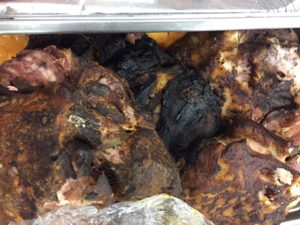
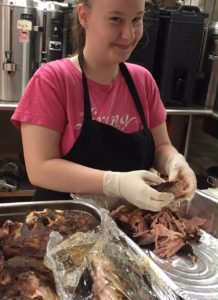
Perfect roast pork shoulder
Since I’m not looking for pulled pork, I calculated my magic number at 175-185 degrees. I figured that way after I take the roast out and tent it, it will reach almost 190 when ready to carve. I’ll have succulent pork which won’t be mui and fall apart when I slice it.
I started roasting the pork at about 10 am, and had it out by about 4 pm. with internal temp at 175 degrees. It sliced beautifully but I think it can get even more tender. Next time I’ll push it to 180 degrees.
To brown or not
Some recipes called for browning at 450 degrees or more at the start. Others called for a quick singe right at the end of cooking. Here are my thoughts on this.
Really, by the time your roast has baked for 6-7 hours, the roast is already beautifully browned. This was how mine looked.
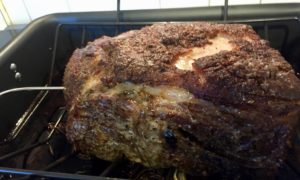
For my first roast I singed it at the beginning–which reduced the cooking time quite a bit but this also cooked the outside rim more. For my second (the same one above) I browned it at 450 degrees for about 5 minutes. Here’s how it came out.
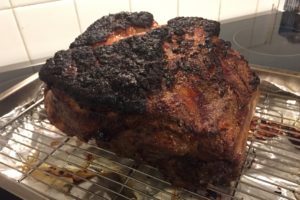
Yikes. Look at the burned surfaces. What was I thinking? I think I could have skipped it. It was already perfect. I guess I was following some instructions without thinking. Life lesson here: Sometimes you gotta do what’s right for you.
For browning at the end of cooking my conclusion is: If it looks nicely brown leave it. If it would look cosmetically better with a singe then brown it for a short time–5 minutes–at 450 or 500 degrees.
Good idea: One recipe called for warming the roast at about 350-400 degrees for about 10-15 minutes after tenting and just before slicing and serving. I think this is a great idea especially if you are making your roast ahead. Just watch you don’t burn it like I did with one. That recipe (see NOTES below) also said you could keep your roast on the counter for up to 5 hours! I’m cautious about that; depending on what temperature your kitchen is in.
I think heating it up at 350-400 degrees just before serving is a great idea especially if you are making your roast ahead by two or more hours.
Tenting
Do tent. Cover roast loosely with aluminum foil for at least 15 minutes. for AFTER tenting, you can also heat it up at 350-400 degrees for 5-10 minutes to reheat the surface just before serving.
Marinating Pork Shoulder
Some purist like it with just salt and pepper. I also only marinate my Roast Pork Belly with salt and Shao Hsing wine. With my holiday roasts I rubbed the shoulder with grounded up black peppercorns and coriander seeds and mixed it with brown sugar. Then I smothered it with mayonnaise with mustard, Worcestershire sauce and soy sauce. I liked it.
Some recipes call for making crosshatch cuts on the surface of the pork and some don’t. I did.
I served my roast with Chumichurri Sauce that I got from America’s Test Kitchen and a Balsamic Glazed Fall Fruit With Rosemary. a side dish of sauteed pears with apples that I learned at a street market.
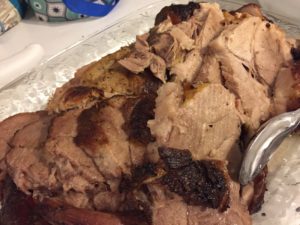
ROAST PORK SHOULDER
Preparation time: 15 minutes
Marinating time: Overnight
Cooking time: 6-8 hours
Spice rub and marinade
1 tablespoon coriander seed
1 tablespoon black peppercorns
⅓ cup brown sugar
½ cup mayonnaise
1 tablespoon mustard
1 tablespoon Worcestershire Sauce
1 tablespoon soy sauce
1 pork shoulder butt cut, or Boston cut, 7-8 pounds, bone in
1 bottle white wine or 1 quart apple juice
1 small onion, sliced
In a blender, or with a mortar and pestle, grind coriander seed with peppercorns. Add brown sugar and set aside. In a bowl blend, mayonnaise with mustard, Worcestershire sauce and soy sauce.

Rub spices and sugar over pork. Smother and cover with mayonnaise. Leave to marinade in fridge overnight.
Roasting: Heat oven to 250 degrees. You don’t have to bring roast to room temperature.
Place rack in a roasting pan. Place onions and pour wine into pan. Place pork shoulder on rack with skin or fat side up. Place probe thermometer into middle of roast, avoiding the bone.
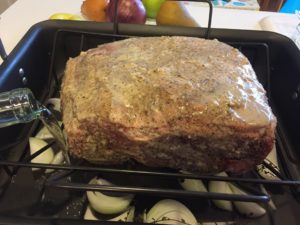
Roast for 6-7 hours until the internal temperature is 175-180 degrees. Remove roast from oven. Tent it with foil. Let sit for at least 1 hour or up to 3 hours.
To reheat pork just before serving, place roast in 350-400 degree oven to warm and brown surface, about 5-10 minutes. Slice and serve on warm platter. Serve immediately.
NOTES
Picking the roast
–I used a Smithfield Pork Shoulder Boston Cut. Sometimes it’s called a butt roast. The regular supermarkets sell pork shoulders at good prices. A shoulder of about 7-8 pounds can sometimes be less than $20. It costs less than a beef roast.
Look for even marbling. I avoided those that had large blobs of fat, but also avoided those that looked too lean. If you are going to eat pork shoulder, I don’t think you’re the kind to worry about fatty pork. I also asked the butcher what he thought and we made the same choice.
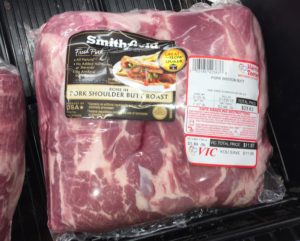
Serving notes
With one pork shoulder I left it sitting tented for about two hours. I then transported it covered to a potluck dinner where I sliced it. It stayed nicely warm, even in our wintry weather. With another it tented for about 20 minutes.
Roast may sit tented on kitchen counter for more than two hours. To reheat, set oven at 400 degrees and roast for 5-10 minutes until fat is sizzling. Slice and serve immediately.
In the recipe for Roast Pork from Bon Appetit–which I modified my recipe from–the instruction was to leave the pork on the counter for up to 5 hours (whoohoo!). It says “Just before serving, reheat roast in a 350-400 degrees oven to soften fat and warm the surface of the roast (but don’t let it take on any more color, 5-10 minutes.” I don’t know why I didn’t follow that. Sounds like good advice.
Accompaniments
Chef Todd mixes his pulled pork with apple cider vinegar and Texas Pete Hot Sauce. Try this sauce to dribble over the pork slices.
Cider Vinegar and Texas Pete Sauce
1½ cups apple cider vinegar
1 tablespoon Texas Pete Hot Sauce
1 tablespoon brown sugar
1 teaspoon salt
In a bowl, blend together ingredients and serve with roast pork.


